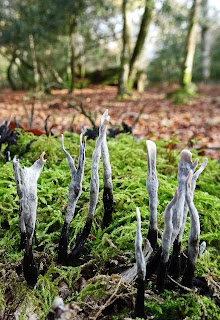P. hymenina is supposedly common
and widespread, but I had only come across it in field guides up until now.
On this same log were several other lichens (including Cladonia
digitata), lots of mosses and a single Scots pine seedling.
CR.
P. hymenina is supposedly common
and widespread, but I had only come across it in field guides up until now.
On this same log were several other lichens (including Cladonia
digitata), lots of mosses and a single Scots pine seedling.
CR.
 |
| Barnacle Geese amongst Canada and Brent Geese |
Next came a large flock of Golden Plover and 2 Ruff on Pennington Marsh, one of which was very active and doing a passable impression of a snowman/bird! All of the usual suspects were on Fishtail but the Pintail (M) get the award for the snappiest dressers. We turned back from the junction of Keyhaven and Fishtail Lagoons and continued via Butts, Jetty and Pennington Lagoons, Oxey Marsh, Salterns Marsh and 8 Acre Pond to the undoubted highlight, Normandy Marsh. Because of the state of the tide birds were crammed into the lagoons and its islands.
 |
| Ringed Plover and Dunlin |
Neither they nor us were sheltered from the sudden arrival of squally winds and heavy rain/hail/sleet but we managed to see: Avocet, Red-breasted Merganser (M+F), Goldeneye (F), Kingfisher, Dunlin, Curlew, Cormorant, Great Black-backed Gull, Ringed Plover, Grey Plover, Lapwing, Shelduck, Shoveler, Redshank, Greenshank, Oystercatcher and Snipe.
 |
| Avocet |
 |
| Seasonal pond at Nomansland Green. MW |
 |
| Sulphur Tuft (Hypholoma fasciculare) MR |
Somewhat chewed, we made a hasty exit down the path through mixed woodland, tramping in thick, leafy layers below spindly birch and large beech, now almost bare, though oak was hanging on to rich-brown leaves. The little gully we crossed was in modest flow after recent rain that had benefited the bright, feathery tufts of Hard Fern (Blechnum spicant) overhanging the bank.
 |
| Hard Fern (Blechnum spicant) MW |
Joining a wide ride we continued downhill then turned left uphill towards Bramshaw Wood carpark. Several trees have fallen here over the years in messy tangles, bearing more Sulphur Tuft and stacks of Turkey Tail (Trametes versicolor). Tiny, glistening-white clumps of Porcelain Fungus (Oudemansiella mucida) contrasted with the hard, black blobs of King Alfred’s Cakes/Cramp Balls (Daldinia concentrica). Missing our field companions, we struggled with identifying some fungi but thought they might be Mycena sp. and/or Russula sp.
Just short of the parking area we turned south-east onto the old Church Path. Heading steadily downhill, ignoring any side paths, we reached a bog, dry-ish in summer but now very wet. Apart from some clumps of black and grey Candlesnuff (Xyaria hypoxylon) on mossy mounds, the only creature of note was a large golden retriever, revelling in traipsing through the mud up to its belly, clearly on borrowed time pending the arrival of the owner.
 |
| Candlesnuff (Xyaria hypoxylon) MW |
 |
| Turkey Tail (Trametes versicolor) MR |
 |
| Cramp Balls (Daldinia concentrica) SP |
 |
| SP |
Birds were clearly otherwise engaged this morning, making brief appearances or just calling from afar. Hence, we bagged only Blackbird, Blue Tit, Carrion Crow, Common Buzzard (heard), Jackdaw, Nuthatch (heard), Robin and Woodpigeon. MW/SP/MR
On a misty morning Richard Smith, Diane and I set off from Bolderwood car park to look for winter thrushes.
We walked past the Deer Sanctuary (no deer or birds to be seen) and continued on the path downhill. It didn’t seem very promising as all we saw at first were robins, dunnocks and blackbirds but as we got further on there was movement above and around us. Long-tailed, great and blue tits, treecreeper, nuthatches and goldcrests were constantly on the move in the trees giving us good, if fleeting, views.
The shortcut that we usually take on this part of the walk was so squelchy that we stayed on the hard path until it met the cycle path at a T-junction, where we turned right to head up to the holly plantation. The birds were more obliging here with nuthatches feeding on the path and a goldcrest moving about in the bracken.
Nuthatch - RS
CR
Map:
We arranged to meet Richard Smith a couple of days early for our walk, due to the poor forecast for Thursdays weather . Meeting up at Setley Pond in early morning sunshine we immediately saw the grey heron, as Setley is known for its long standing heronry. Walking towards the A337 on first the heath and then through narrow paths we noted fresh rabbit holes, a field of crows and a pair of probably goldfinches flying swiftly away.